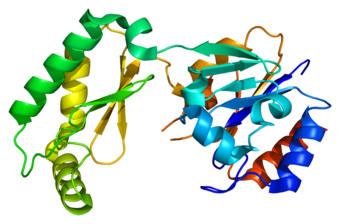Medicine:PMM2 deficiency
| PMM2 deficiency | |
|---|---|
| Other names | Carbohydrate-deficient Glycoprotein Syndrome (CDGS) Type Ia, Congenital Disorder of Glycosylation (CDG) Type Ia,Phosphomannomutase Deficiency[1],Jaeken Syndrome, PMM2-CDG , CDG1a |
 | |
| PMM2 protein | |
PMM2 deficiency or PMM2-CDG, previously CDG-Ia, is a very rare genetic disorder caused by mutations in PMM2. It is an autosomal recessive disease that is the most common type of congenital disorder of glycosylation or CDG.[2] PMM2-CDG is the most common of a growing family of more than 130 extremely rare inherited metabolic disorders.[3] Only about 800 children and adults have been reported worldwide.[4]
Signs and symptoms
- Failure to thrive (FTT) - Failure to gain weight and grow at the expected rate.[5]
- Cerebellar hypoplasia - Small cerebellum, which is the part of the brain that coordinates movement.[6][7][8][9][10]
- Liver disease - Elevated liver function tests.[11]
- Pericardial effusion - Fluid around the heart.[12]
- Peripheral neuropathy (PN) - Impaired nerve impulse transmission to the legs. Patients do not respond well to reflex tests.[13]
- Strabismus - Crossed eyes, mainly presented as infantile esotropia[14]
- Nystagmus - Involuntary eye movements caused by cerebellar ataxia.[14][15]
- Hypotonia - Weak muscle tone, commonly known as floppy baby syndrome.[16]
Diagnosis
PMM2 deficiency is diagnosed through genetic sequencing. More than 115 mutations in the PMM2 gene have been found to cause this disease.[16]
Treatment
Treatment with mannose powder 1 to 2 g / kg per day results in significant improvement in protein glycosylation after 1 year.[17] Other treatments involve management of the symptoms that are apparent in each individual, including physical therapy to improve core strength and mobility, occupational therapy for coordination, speech therapy for talking and eating.[13]
References
- ↑ "Mutations in PMM2, a phosphomannomutase gene on chromosome 16p13, in carbohydrate-deficient glycoprotein type I syndrome (Jaeken syndrome)". Nature Genetics 16 (1): 88–92. May 1997. doi:10.1038/ng0597-88. PMID 9140401.
- ↑ "Congenital Disorders of Glycosylation (CDG)". https://www.chop.edu/pages/congenital-disorders-glycosylation-cdg-forms.
- ↑ "Congenital Disorders of Glycosylation (CDG)". https://www.chop.edu/conditions-diseases/congenital-disorders-glycosylation-cdg.
- ↑ "PMM2-CDG". National Organization for Rare Disorders (NORD). 6 August 2015. https://rarediseases.org/rare-diseases/pmm2-cdg/.
- ↑ "Subcutaneous fat pads on body MRI--an early sign of congenital disorder of glycosylation PMM2-CDG (CDG1a)". Pediatric Radiology 44 (2): 222–5. February 2014. doi:10.1007/s00247-013-2782-2. PMID 24037084.
- ↑ "Stroke-Like Episodes and Cerebellar Syndrome in Phosphomannomutase Deficiency (PMM2-CDG): Evidence for Hypoglycosylation-Driven Channelopathy". International Journal of Molecular Sciences 19 (2): 619. February 2018. doi:10.3390/ijms19020619. PMID 29470411.
- ↑ "A quantitative assessment of the evolution of cerebellar syndrome in children with phosphomannomutase-deficiency (PMM2-CDG)". Orphanet Journal of Rare Diseases 12 (1): 155. September 2017. doi:10.1186/s13023-017-0707-0. PMID 28915903.
- ↑ "Erratum to: Longitudinal volumetric and 2D assessment of cerebellar atrophy in a large cohort of children with phosphomannomutase deficiency (PMM2-CDG)". Journal of Inherited Metabolic Disease 40 (5): 753–754. September 2017. doi:10.1007/s10545-017-0056-0. PMID 28600669.
- ↑ "Phosphomannomutase deficiency (PMM2-CDG): ataxia and cerebellar assessment". Orphanet Journal of Rare Diseases 10: 138. October 2015. doi:10.1186/s13023-015-0358-y. PMID 26502900.
- ↑ "Congenital disorders of glycosylation with emphasis on cerebellar involvement". Seminars in Neurology 34 (3): 357–66. July 2014. doi:10.1055/s-0034-1387197. PMID 25192513.
- ↑ "Liver involvement in congenital disorders of glycosylation (CDG). A systematic review of the literature". Journal of Inherited Metabolic Disease 40 (2): 195–207. March 2017. doi:10.1007/s10545-016-0012-4. PMID 28108845.
- ↑ "Cardiomyopathy in the congenital disorders of glycosylation (CDG): a case of late presentation and literature review". Journal of Inherited Metabolic Disease 32 (Suppl 1): S313-9. December 2009. doi:10.1007/s10545-009-1262-1. PMID 19757145.
- ↑ 13.0 13.1 Sparks, Susan E.; Krasnewich, Donna M. (1993). "PMM2-CDG (CDG-Ia)". in Adam, Margaret P.. GeneReviews®. Seattle (WA): University of Washington, Seattle. https://www.ncbi.nlm.nih.gov/books/NBK1110/.
- ↑ 14.0 14.1 "Ophthalmic findings in an infant with phosphomannomutase deficiency". Documenta Ophthalmologica. Advances in Ophthalmology 128 (2): 149–53. April 2014. doi:10.1007/s10633-014-9427-0. PMID 24493206.
- ↑ "Child Neurology: a case of PMM2-CDG (CDG 1a) presenting with unusual eye movements". Neurology 79 (15): e131-3. October 2012. doi:10.1212/WNL.0b013e31826e2617. PMID 23045520.
- ↑ 16.0 16.1 "PMM2 gene" (in en). https://ghr.nlm.nih.gov/gene/PMM2#conditions.
- ↑ Taday, Roman; Grüneberg, Marianne; DuChesne, Ingrid; Reunert, Janine; Marquardt, Thorsten (2020-09-22). "Dietary mannose supplementation in phosphomannomutase 2 deficiency (PMM2-CDG)". Orphanet Journal of Rare Diseases 15 (1): 258. doi:10.1186/s13023-020-01528-z. ISSN 1750-1172. PMID 32962735.
 |

